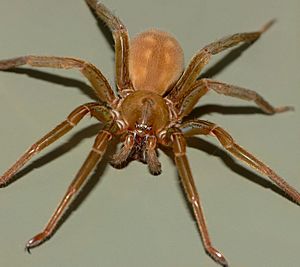Pianoa facts for kids
Quick facts for kids Pianoa |
|
|---|---|
 |
|
| Scientific classification |
The Pianoa is a special type of spider found only in New Zealand. It's a monotypic genus, which means it's a group of spiders with only one known species. This single species is called Pianoa isolata, but most people know it as the piano flat spider.
Scientists Raymond Robert Forster, Norman I. Platnick, and Michael R. Gray first described this unique spider in 1987.
Contents
Where the Piano Flat Spider Lives
The piano flat spider can be found in the Waikaia forest and other areas. These places are in northern Southland and western Otago in New Zealand.
What the Piano Flat Spider Looks Like
When they are very young, piano flat spiders are pale white. They don't have any special marks on their bodies. But as they grow, they shed their skin several times. After these molts, their bodies start to get their color.
The eggs of the piano flat spider are laid in sacs. These egg sacs are usually a pale cream or white color.
Piano Flat Spider Habitat
P. isolata spiders like to live on the forest floor. You can often find them among fallen leaves and in rotting logs. These places provide good shelter for them.
Behavior and Diet
The piano flat spider is a nocturnal creature. This means it is most active at night. Unlike many spiders, it does not build a web to catch its food. Instead, it is an active hunter.
This spider has a special tool for hunting: a large claw on its first and second legs. It uses this claw to grab its prey. Once it catches something, it bites its prey many times.
Reproduction and Life Cycle
Female piano flat spiders lay their egg sacs inside hollow spaces in fallen logs. This usually happens in late spring to early summer.
After about three to four weeks, the baby spiders, called juveniles, hatch. They come out of a small hole at the bottom of the egg sac.
Conservation Status
The Department of Conservation has classified the piano flat spider as "At Risk (Relict)". This means that while it's not critically endangered, it's a species that needs attention to make sure its population stays healthy.
See also
 In Spanish: Pianoa para niños
In Spanish: Pianoa para niños

